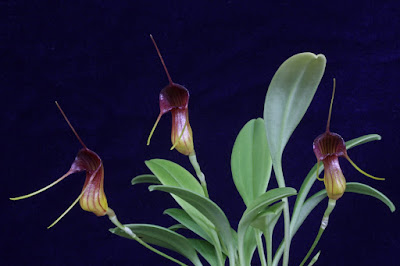The plant is small, 6-7cm tall, and the flowers which are held on spikes near the top of the leaves are 7cm tall from the tips of the tails. The flowers have a faint sweetish scent that I cannot identify and have hair-like glands on the inside of the tube. The plant hails from Ecuador.
Tuesday, May 24, 2011
Masdevallia ampullacea 'Connor' CHM/AOS
Masdevallia ampullacea is another species in the saltatrices section of the genus Masdevallia. That translates into tubular flowers with longish tails and a kind of bulging "belly" at the base of the flowers. This group includes many of my favorite Masdevallia species.
The plant is small, 6-7cm tall, and the flowers which are held on spikes near the top of the leaves are 7cm tall from the tips of the tails. The flowers have a faint sweetish scent that I cannot identify and have hair-like glands on the inside of the tube. The plant hails from Ecuador.
The plant is small, 6-7cm tall, and the flowers which are held on spikes near the top of the leaves are 7cm tall from the tips of the tails. The flowers have a faint sweetish scent that I cannot identify and have hair-like glands on the inside of the tube. The plant hails from Ecuador.
Labels:
chm/aos,
ecuador,
masdevallia,
masdevallia ampullacea,
orchid,
pleurothallid
Saturday, May 21, 2011
Muscarella megalops
Also known as Specklinia megalops and Pleurothallis megalops, this unusual species is from the Ecuadorean Andes. The plant is only about 5 cm tall and the few, widely spaced flowers are carried on wiry spikes that tend to hang down. The name, megalops, refers to the very large (and hairy) lip that is characteristic of this species.
Labels:
ecuador,
muscarella,
muscarella megalops,
orchid,
pleurothallid,
pleurothallis,
pleurothallis megalops,
specklinia
Monday, May 9, 2011
Masdevallia filaria
Masdevallia filaria is another species from the Saltatrices section of Masdevallia. Compared with the flowers of Masdevallia ventricularia in the previous post the relationship is obvious. Both have the tubular shape and "belly" that are characteristic of this section.
The plant of this species is about 10 cm tall and the flowers 5 cm in height. Like the previous species it blooms in the spring and comes from Colombia. Its name, filaria, refers to the thread-like tails of the flowers and it sometimes considered to be the same species as ventricularia.
The plant of this species is about 10 cm tall and the flowers 5 cm in height. Like the previous species it blooms in the spring and comes from Colombia. Its name, filaria, refers to the thread-like tails of the flowers and it sometimes considered to be the same species as ventricularia.
Labels:
colombia,
masdevallia,
masdevallia filaria,
orchid,
pleurothallid,
saltatrices
Monday, May 2, 2011
Dracula lotax
This is one of those orchid names that makes me laugh. There is a whole group of orchids, well over a hundred species, called Draculas, named for their odd flowers and their fancied resemblance to a dragon's mouth. They are related to Masdevallia and belong to the group of Central and South American orchids known as Pleurothallids.
The name of this species is especially humorous since lotax means "clown," so that it is literally the "Clown Dracula," which is rather incongruous. It is so named however, because it has a little clown's face in the center of the flower. It is the name Dracula that really does not fit, since this miniature species does not have the dark, bat-wing flowers of some other species in the genus.
The plant is 12 cm tall and the flowers about half that size. It requires relatively low light, cool and damp conditions, and can be grown in a pot since its flower spikes are held upright, unlike those species that send their spikes downward. I grow it in live sphagnum moss in a net pot and keep it as far away from the lights as is possible in my orchidarium.
The name of this species is especially humorous since lotax means "clown," so that it is literally the "Clown Dracula," which is rather incongruous. It is so named however, because it has a little clown's face in the center of the flower. It is the name Dracula that really does not fit, since this miniature species does not have the dark, bat-wing flowers of some other species in the genus.
The plant is 12 cm tall and the flowers about half that size. It requires relatively low light, cool and damp conditions, and can be grown in a pot since its flower spikes are held upright, unlike those species that send their spikes downward. I grow it in live sphagnum moss in a net pot and keep it as far away from the lights as is possible in my orchidarium.
Labels:
dracula,
dracula lotax,
ecuador,
orchid,
pleurothallid
Subscribe to:
Comments (Atom)












